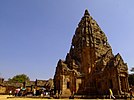This article needs additional citations for verification. (January 2020) |
Northeastern Region
ภาคตะวันออกเฉียงเหนือ | |
|---|---|
|
From upper-left to lower-right: Thai–Lao Friendship Bridge, Phu Kradueng, Khao Yai, Phanom Rung Historical Park and Candle Festival | |
 Northeastern Region in Thailand | |
| Capital | Khon Kaen |
| Largest city | Nakhon Ratchasima |
| Provinces | |
| Area | |
| • Total | 167,718 km2 (64,756 sq mi) |
| Population (2019)[2] | |
| • Total | 22,017,248 |
| • Density | 130/km2 (340/sq mi) |
| Demonym | Khon Isan |
| GDP | |
| • Total | US$51.5 billion (2019) |
| Time zone | UTC+7 (ICT) |
| Language | Isan • others |
Northeastern Thailand, also known as Isan,[a] consists of 20 provinces in northeastern Thailand. Isan is Thailand's largest region, on the Khorat Plateau, bordered by the Mekong River (along the Laos–Thailand border) to the north and east, by Cambodia to the southeast and the Sankamphaeng Range south of Nakhon Ratchasima. To the west it is separated from northern and central Thailand by the Phetchabun Mountains. Isan covers 167,718 km2 (64,756 sq mi), making it about half the size of Germany and roughly the size of England and Wales. The total forest area is 25,203 km2 (9,731 sq mi) or 15 percent of Isan's area.[1]
Since the beginning of the 20th century, northeastern Thailand has been generally known as Isan, while in official contexts the term phak tawan-ok-chiang-nuea (ภาคตะวันออกเฉียงเหนือ; "northeastern region") may be used. The majority population of the Isan region is ethnically Lao, but distinguish themselves not only from the Lao of Laos but also from the Central Thai by calling themselves khon Isan or Thai Isan in general. But some refer to themselves as simply Lao, and academics have recently been referring to them as Lao Isan[5] or as Thai Lao, with the main issue with self-identification as Lao being stigma associated with the Lao identity in Thai society.[6]
The Lao Isan people are aware of their Lao ethnic origin, but Isan has been incorporated as a territory into the modern Thai state through over 100 years of administrative and bureaucratic reforms, educational policy, and government media. Despite this, since the election of Thaksin Shinawatra as prime minister in the 2001 Thai general election, the Lao Isan identity has reemerged, and the Lao Isan are now the main ethnolinguistic group involved in the pro-Thaksin "Red Shirt movement" of the United Front for Democracy Against Dictatorship.[7] Several Thai prime ministers have come from the region.
- ^ a b ตารางที่ 2 พี้นที่ป่าไม้ แยกรายจังหวัด พ.ศ.2562 [Table 2 Forest area Separate province year 2019]. Royal Forest Department (in Thai). 2019. Retrieved 6 April 2021. Information, Forest statistics Year 2019, Thailand boundary from Department of Provincial Administration in 2013
- ^ รายงานสถิติจำนวนประชากรและบ้านประจำปี พ.ส.2562 [Statistics, population and house statistics for the year 2019]. Registration Office Department of the Interior, Ministry of the Interior. stat.bora.dopa.go.th (in Thai). 31 December 2019. Archived from the original on 14 June 2019. Retrieved 26 February 2020.
- ^ "Gross Regional and Provincial Product, 2019 Edition". <>. Office of the National Economic and Social Development Council (NESDC). July 2019. ISSN 1686-0799. Retrieved 22 January 2020.
- ^ Klaus Glashoff. "Spoken Sanskrit". learnsanskrit.cc. Retrieved 18 September 2021.
- ^ Premsrirat, Suwilai (2007), "Endangered languages of Thailand", International Journal of the Sociology of Language (186): 76, doi:10.1515/ijsl.2007.043, ISSN 0165-2516, S2CID 144238668
- ^ Draper, John; Prasertsri, Paweena (2013), "The Isan Culture Maintenance and Revitalisation Programme's multilingual signage attitude survey", Journal of Multilingual and Multicultural Development, 34 (7): 618, doi:10.1080/01434632.2013.814659, ISSN 0143-4632, S2CID 143763692
- ^ Keyes, Charles (2013), Finding Their Voice: Northeastern Villagers and the Thai State, Silkworm Books, ISBN 978-6162150746
Cite error: There are <ref group=lower-alpha> tags or {{efn}} templates on this page, but the references will not show without a {{reflist|group=lower-alpha}} template or {{notelist}} template (see the help page).




